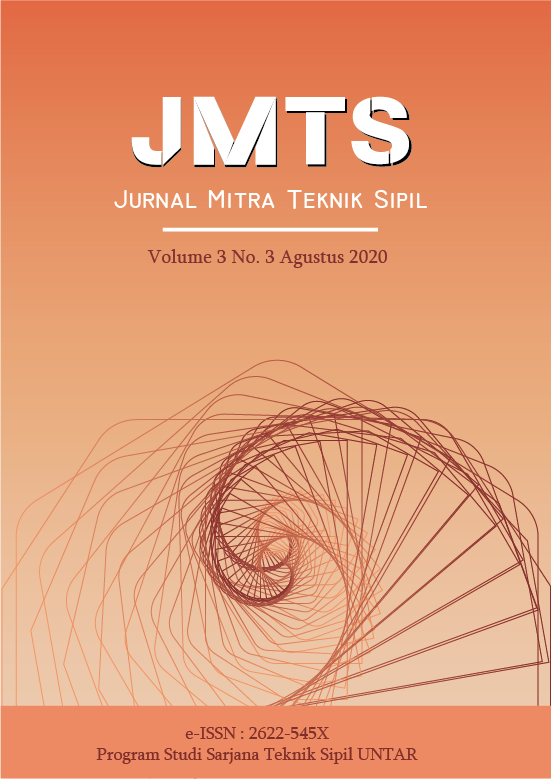PERANCANGAN FONDASI TIANG PANCANG PADA TANAH BERPOTENSI LIKUIFAKSI DI SULAWESI
Main Article Content
Abstract
ABSTRACT
Indonesia is a country located in the most active earthquake paths in the world. This makes Indonesia prone to earthquakes and has the potential to experience liquefaction. Liquefaction can cause pile failure, so several things need to be considered in designing piles on potentially liquefied soils. One project in Sulawesi has a profile of uniform grained saturated soil that is susceptible to liquefaction. Two things that need to be considered in the design of piles on potentially liquefied soils is to ignore the capacity of pile friction and calculate the moment due to lateral spreading effects. Calculation of liquefaction potential is done by comparing the ratio of the cyclic stress and the cyclic resistance ratio and is compared by four other methods namely: the Seed et al. (2003), Tsuchida (1970), Seed et al. (2003), and Bray & Sancio (2004). The lateral spreading effect is calculated by referring to the JRA Code where the liquefied soil layer gives pressure to the pile at 30% of the overburden stress and the soil layer above the liquefied soil gives passive soil pressure to the pole. The moment effect caused by lateral spreading results in the addition of dimensions or number of poles.
Keywords: liquefaction; lateral spreading; bearing capacity; JRA Code; pile foundation
ABSTRAK
Indonesia adalah negara yang terletak di jalur gempa teraktif di dunia. Hal ini menyebabkan Indonesia rawan gempa dan memiliki potensi untuk mengalami likuifaksi. Likuifaksi dapat menyebabkan kerusakan/kegagalan struktur yang sangat merugikan, sehingga perlu diperhatikan beberapa hal dalam merancang tiang pada tanah berpotensi likuifaksi. Salah satu proyek di Sulawesi memiliki profil tanah pasir berbutir seragam dan jenuh air yang memiliki potensi likuifaksi. Dua hal yang perlu diperhitungkan dalam perancangan tiang pada tanah berpotensi likuifaksi adalah mengabaikan daya dukung friksi tiang dan memperhitungkan momen akibat efek lateral spreading. Perhitungan potensi likuifaksi dilakukan dengan membandingkan rasio tegangan siklik (CSR) dan rasio hambatan siklik (CRR) serta dibandingkan dengan empat metode lainnya yaitu: metode Seed et al. (2003), Tsuchida (1970), Seed et al. (2003), dan Bray & Sancio (2004). Daya dukung aksial pada tiang pancang mengalami pengurangan 32% akibat lapisan tanah yang terlikuifaksi. Efek lateral spreading dihitung dengan acuan JRA Code dimana lapisan tanah terlikuifaksi memberikan tekanan ke tiang sebesar 30% dari tegangan overburden dan lapisan tanah di atas tanah terlikuifaksi memberikan tekanan tanah pasif ke tiang. Efek momen yang diakibatkan oleh lateral spreading mengakibatkan penambahan dimensi ataupun jumlah tiang.
Kata kunci: likuifaksi; lateral spreading; daya dukung; JRA Code; fondasi tiang
Article Details
References
Das, Braja M. Principles of Foundation Engineering. Global Engineering: Christopher M. Shortt, 2011.
—. Principles of soil dynamics. PWS.KENT, 1993.
Prakash, Shamsher. Soil Dynamics. Missouri: McGraw-Hill, 1981.
Rahardjo, P.P. Manual Pondasi TIang Edisi 3. 2005.
Sancio, J. D. Bray and R. B. "Assessment of The Liquefaction Susceptibility of Fine Grained Soil." Journal of Geotechnical Engineering (2006): 1165–1177.
Seed, H.B. and I.M. Idriss. Ground Motions and Soil Liquefaction during Earthhquakes. Calfornia, 1982.
Tsuchida, H. "Prediction and countermeasure against the liquefaction in sand deposits." Seminar in the Port and Harbor Research Institute, (1970).
Wang, W. "Some Findings in Soil Liquefaction." Report Water Conservancy and Hydro-electric (1979): 1-17.
JRA. Japanese Road Association, Specification for Highway Bridges, Part V, Seismic. 1996.



